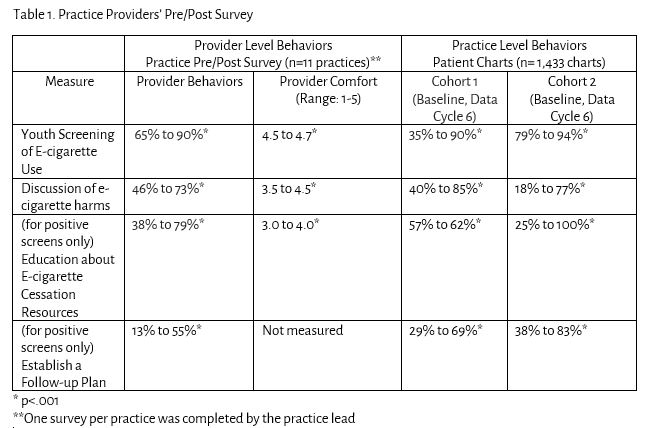Adolescent Medicine: General
Category: Abstract Submission
Adolescent Medicine I
487 - Feasibility of a Quality Improvement Project for Adolescent E-cigarette Use
Friday, April 22, 2022
6:15 PM - 8:45 PM US MT
Poster Number: 487
Publication Number: 487.100
Publication Number: 487.100
Kristen R. Kaseeska, American Academy of Pediatrics, Itasca, IL, United States; Page Pomo, Farmington Community Health Center---Presbyterian Medical Services, Farmington, NM, United States; Thaina Rousseau-Pierre, Mount Sinai School of Medicine, Elmhurst, NY, United States; S. Christy Sadreameli, Johns Hopkins University School of Medicine, Baltimore, MD, United States; Paula C. Martin, American Academy of Pediatrics, Itasca, IL, United States; Shannon Limjuco, American Academy of Pediatrics, Itasca, IL, United States; Rachel Boykan, Renaissance School of Medicine at Stony Brook University, Stony Brook, NY, United States

Kristen R. Kaseeska, MPH (she/her/hers)
Manager, Suicide Prevention
American Academy of Pediatrics
Itasca, Illinois, United States
Presenting Author(s)
Background: The US Surgeon General has declared youth e-cigarette use an epidemic. Significant work is needed to prevent youth from initiating use and to support those already addicted to nicotine. Pediatric providers are a trusted resource for youth e-cigarette prevention and cessation.
Objective: Describe the feasibility of a telementoring quality improvement (QI) program leveraging Project ECHO (Extension for Community Healthcare Outcomes) for adolescent e-cigarette use in primary care practice.
Design/Methods: Primary care practices from two cohorts (Cohort 1: Jun–Dec 2020; Cohort 2: Jan–Jul 2021) participated in an ECHO aimed at improving e-cigarette screening and counseling to adolescents. Practices participated in monthly, bi-directional learning sessions and entered monthly chart data from ≥10 adolescent patients ages 13-21 for 6 months. Practice and provider surveys assessed self-reported procedures and comfort related to e-cigarette screening and counseling. Chart data was used to assess changes in e-cigarette screening and counseling practice.
Results: 58 multi-disciplinary providers (62% physicians, 35% other clinicians, 3% administrative staff) from 23 practices (39% community primary care, 26% hospital primary care, 35% multi-care) participated. 11 practices (48%) completed a pre/post survey; practices described overall increase in staff’s ability and comfort in youth e-cigarette screening, discussing harms associated with e-cigarette use, presenting cessation resources, and establishing a follow-up plan (pConclusion(s): Participants in a telementoring QI program increased primary care clinician comfort and practice ability to screen and counsel for adolescent e-cigarette use. Clinical interventions should include a multi-disciplinary approach to ensure consistent e-cigarette screening and counseling. The ECHO model provides methodology to inform pediatric health providers in addressing adolescent e-cigarette use.
Practice Providers’ Pre/Post Survey
Objective: Describe the feasibility of a telementoring quality improvement (QI) program leveraging Project ECHO (Extension for Community Healthcare Outcomes) for adolescent e-cigarette use in primary care practice.
Design/Methods: Primary care practices from two cohorts (Cohort 1: Jun–Dec 2020; Cohort 2: Jan–Jul 2021) participated in an ECHO aimed at improving e-cigarette screening and counseling to adolescents. Practices participated in monthly, bi-directional learning sessions and entered monthly chart data from ≥10 adolescent patients ages 13-21 for 6 months. Practice and provider surveys assessed self-reported procedures and comfort related to e-cigarette screening and counseling. Chart data was used to assess changes in e-cigarette screening and counseling practice.
Results: 58 multi-disciplinary providers (62% physicians, 35% other clinicians, 3% administrative staff) from 23 practices (39% community primary care, 26% hospital primary care, 35% multi-care) participated. 11 practices (48%) completed a pre/post survey; practices described overall increase in staff’s ability and comfort in youth e-cigarette screening, discussing harms associated with e-cigarette use, presenting cessation resources, and establishing a follow-up plan (pConclusion(s): Participants in a telementoring QI program increased primary care clinician comfort and practice ability to screen and counsel for adolescent e-cigarette use. Clinical interventions should include a multi-disciplinary approach to ensure consistent e-cigarette screening and counseling. The ECHO model provides methodology to inform pediatric health providers in addressing adolescent e-cigarette use.
Practice Providers’ Pre/Post Survey

